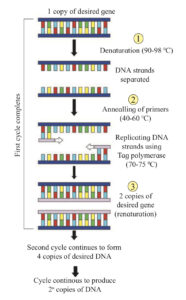Polymerase Chain Reaction (PCR) is a technique for in vitro amplification of a target gene using a PCR machine.
i. PCR has the capability to produce a billion copies of the desired DNA or RNA segment with high accuracy and specificity within a few hours.
ii. This automated process involves thermal cycles for denaturation and renaturation of double-stranded DNA, all conducted within a PCR machine.
iii. The essential apparatus for PCR is known as a thermal cycler.
iv. Necessary components for polymerase chain reaction include DNA containing the target segment, deoxyribonucleoside triphosphates (dNTPs), two primer molecules in excess, heat-stable DNA polymerase, and appropriate quantities of Mg++ ions.
Mechanism of PCR:
At the outset, all required components are combined in an ‘Eppendorf tube,’ and the following steps are sequentially performed:
Step i: Denaturation
The reaction mixture is heated to a temperature (90–98oC) to separate the two strands of the desired DNA, a process known as denaturation.
Step ii: Annealing
The mixture is then cooled (40–60oC), facilitating the pairing of primers to complementary DNA sequences. This step is referred to as annealing.
Step iii: Primer Extension / Polymerization
At a temperature of 70–75°C, thermostable Taq DNA polymerase utilizes single-stranded DNA as a template, adding nucleotides in a process called primer extension. This step takes approximately two minutes.
v. Each cycle lasts around 3 to 4 minutes.
vi. To initiate the next cycle, DNA is reheated to convert double-stranded DNA into single strands.
vii. In an automated thermal cycler, these three steps are automatically repeated 20-30 times. Consequently, at the end of ‘n’ cycles, 2n copies of DNA segments are generated.
viii. The machine executes the entire operation automatically and precisely.
 DNA replication through a polymerase chain reaction.
DNA replication through a polymerase chain reaction.